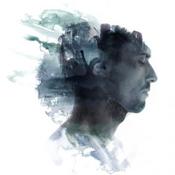 Western culture seems to be increasingly fascinated with the human brain. Emerging evidence in the field of interpersonal neurobiology links physiological processes of the brain with mindfulness and psychotherapy, and most of our efforts to understand illness, disease, creativity, innovation, attention and cognitive ability have long focused on the three pounds of flesh harnessed within our skulls.
Western culture seems to be increasingly fascinated with the human brain. Emerging evidence in the field of interpersonal neurobiology links physiological processes of the brain with mindfulness and psychotherapy, and most of our efforts to understand illness, disease, creativity, innovation, attention and cognitive ability have long focused on the three pounds of flesh harnessed within our skulls.
The brain is only a small percentage of our body weight, but approximately 20% of our energy is required for its operation. Its three main parts, sometimes referred to as the “triune brain,” consist of the brain stem, the limbic system, and the prefrontal cortex. These parts, which evolved in that order, can be thought of as having “stacked up” over millions of years.
The Brain Stem and Limbic System
The brain stem, which is considered the foundation of the brain, travels up the spinal cord and connects to the brain. Because this initial part of the brain operates the basic systems of the body common to most lower-order animals, it is often called the reptilian brain. Processes of the brain stem include the functions most newborns are capable of: they can regulate the body’s temperature, experience pain, digest food, and monitor their breathing as well as heart rate and blood pressure. Babies do not have to think about these processes since they are automated by this lower order aspect of the brain.
The brain stem is connected within the subcortical limbic system. The limbic system can be considered a sort of “center house” for our emotional experiences, a registry for the things in life we move toward or away from. Also known as the mammalian brain, this aspect of the brain is contained within the middle part of the structure and is more evolved than the reptilian brain. The connection between the brain stem and the limbic system is what gives rise to the commonly understood defense mechanisms of fight, flight, or freeze.
The structure largely responsible for reactions to stimuli in our environment is the amygdala, a small, almond-shaped structure in the limbic system. This “smoke detector” of the brain determines whether a sound, image, or body sensation is perceived as a threat or is relevant to survival and activates the body’s stress response, or not, accordingly. When a noise that sounds like gunshot is heard, for example, then the body’s amygdala turns on, releasing stress hormones and nerve impulses to raise blood pressure, oxygen intake, and heart rate in order to prepare the body for fight or flight. An adverse noise can lead to a startle response, or goosebumps, perspiration, and the hair on the back of the neck standing up. The body responds in this way whether we actively think about these things or not.
The Prefrontal Cortex
What separates us, in a number of ways, from other animals is the prefrontal cortex, the so-called “human” brain. This structure lies just behind the forehead and is part of the larger neocortex that envelops the limbic system and contains all the other parts of the brain. Its overlap with the limbic system allows for an interplay between these systems and allows us to regulate our emotional responses.
When we hear a loud noise that could have been a gunshot, we startle, but the higher order processing of the prefrontal cortex allows us to reflect on the stimuli in our environment. After reflection, we might realize the sound was actually a car backfiring or a door slamming and regain a sense of calm. There is a dance of sorts that occurs between the prefrontal cortex and the limbic system. In general, the prefrontal cortex functions to regulate the body by balancing emotion, moderating fear, and granting us the ability to gain insight as well as a deeper understanding of morality, intuition and empathy.
Think back to a time when you were distracted, perhaps with your phone or by a child or partner, while grocery shopping. Executive functioning (discernment of the shopping aisles) becomes increasingly taxing when we are also engaged in a conversation. Our attention is split, and this can overload our working memory. When this occurs, the emotional part of the brain is left unchecked. Sometimes we leave the store and realize our shopping bags are filled with snacks and impulse purchases, not the items we had planned to buy. This occurs in part because shutting down the resources of the prefrontal cortex (talking on the phone) gives full autonomy to the emotional center of the brain, a non-conceptual framework focused on stimuli that grab our attention.
The Triune Brain in Relation to Mental Health
The three aspects of the brain can easily be associated with mental health treatment, psychotherapy, and mindfulness practice.
Individuals who have experienced traumatic events in their lives often have a limbic system (specifically the amygdala) that is overactive, in part because they can become fixated on flashbacks and memories associated with what happened. The ability to regulate and discern safety in their environment becomes challenging, to say the least, and the result of this is often a chronically activated stress response. The ability to name the emotion that coincides with an experience has been shown to decrease this amygdala firing, and psychotherapy, thus, often focuses on developing awareness of emotions within certain contexts in order to gain a wiser understanding of the reasons behind our typical reactions.
Engaging the prefrontal cortex to understand emotional habits and sequences is the essence of most psychotherapy. This top-down approach often has the effect of allowing us to connect with another person we trust and feel safe with. This modulation and intimacy that occurs in the context of a therapeutic relationship gives us the opportunity to comprehend what is going on internally while also helping us learn how to process those memories from our past we might rather avoid. The bottom-up approach to regulating experience happens by constantly returning to what we are doing in the here and now. The constant acceptance of “just this,” without any added judgment of whether we like or dislike what is happening, creates a kind of biological equanimity.
A path increasingly being traveled in contemporary societies is the disruption of symptoms via biological approaches. Pharmaceuticals have burgeoned as a method of altering psychological experiences in the West. Psychotropic medications such as Abilify have the effect of shutting down inappropriate alarm reactions, potentially changing the way the brain organizes information in the short term. The dampening effect of such drugs can provide a temporary solution to hyperactivity or dysregulation, but many find that using these medications prevents them from mastering their emotional responses and learning to self-regulate.
Developing the ‘Human’ Brain
Research suggests one way to exercise and strengthen the human part of the brain is to simply pay attention to the processes automated in our body. Recall the brain stem: it is essentially responsible for our breathing, so we don’t have to remember to breathe in the same way that we might try to remember to use the bathroom before going to a movie, for example.
The bottom-up approach to regulating experience happens by constantly returning to what we are doing in the here and now. The constant acceptance of “just this,” without any added judgment of whether we like or dislike what is happening, creates a kind of biological equanimity. The amygdala is less likely to sound its alarm as the prefrontal cortex becomes a better moderating feature.
Many studies have shown meditation practices create more of an approach orientation for individuals. We become less likely to avoid things and more stable within the storms of everyday life. This is not to say we will stop experiencing emotions and feelings. On the contrary, our senses are often heightened and deepened, and we are able to recover and navigate these moments in a more pointed and skillful way. Bessel van der Kolk notes in his book The Body Keeps the Score that for trauma survivors, a bottom-up approach allows “the body to have experiences that deeply and viscerally contradict the helplessness, rage, or collapse that result from trauma.”
We can use cognition to orient our attention to our experiences and discern how our actions have affected others, but for some, the prefrontal cortex, and the ability for self-reflection granted by it, is both an advantage and a disadvantage. We are able to dredge up the past and ruminate on our anticipated future, but with this comes comprehension of the temporary nature of our circumstances. In other words, we realize our own mortality: we know we will someday die.
Psychotherapy and mindfulness practices, then, merge as bottom-up processes for emotion regulation. Both are methods we can use to begin to recondition a habit or pattern of turning away from what is happening. An acceptance of the temporary nature of our circumstances and an increased focus on compassion, both for ourselves and others, are often direct consequences.
References:
- Briere, J. N., & and Scott, C. (2013) Principles of Trauma Therapy: A Guide to Symptoms, Evaluation, and Treatment. Thousand Oaks, CA: Sage Publications.
- Siegel, D. J. (2010). The Mindful Therapist: A Clinician’s Guide to Mindsight and Neural Integration. New York: W.W. Norton & Company
- van der Kolk, B. A. (2014). The Body Keeps the Score: Brain, Mind, and Body in the Healing of Trauma. New York, NY: Penguin Books.

The preceding article was solely written by the author named above. Any views and opinions expressed are not necessarily shared by GoodTherapy.org. Questions or concerns about the preceding article can be directed to the author or posted as a comment below.

 When Things Get Out of Hand: Trauma and the Triune Brain
When Things Get Out of Hand: Trauma and the Triune Brain Better Brain Chemistry: Sleep, Move, and Breathe to Calm
Better Brain Chemistry: Sleep, Move, and Breathe to Calm Trauma Recovery: Unlinking Fear and Danger in the Brain
Trauma Recovery: Unlinking Fear and Danger in the Brain

Please fill out all required fields to submit your message.
Invalid Email Address.
Please confirm that you are human.
Leave a Comment
By commenting you acknowledge acceptance of GoodTherapy.org's Terms and Conditions of Use.